Here, I try to categorize my some resent researches.
1. Coexistence of multiple species under interspecific competition
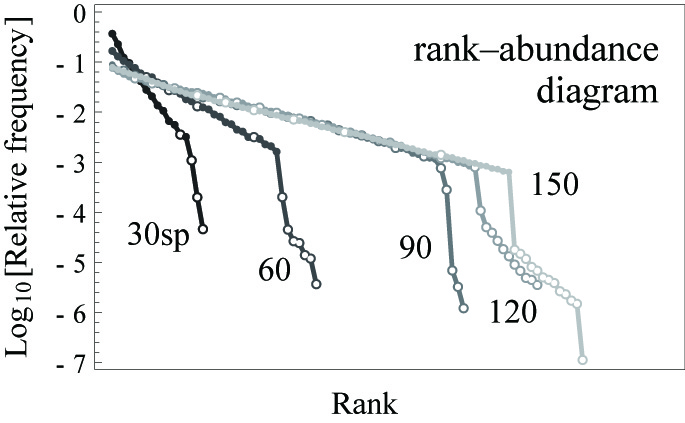
A colonization model provides a useful basis to investigate a role of interspecific competition in species diversity. The model formulates colonization processes of propagules competing for spatially distinct habitats, which is known to result in stable coexistence of multiple species under various trade-off, for example, competition–colonization and fecundity–mortality trade-offs. Based on this model, we propose a new theory to explain patterns of species abundance, assuming a trade-off
between competitive ability and fecundity among species. This model makes testable predictions about species positions in the rank abundance diagram under a discrete species competitiveness. The predictions were tested by three data of animal communities, which supported our model, suggesting the importance of interspecific competition in community structure. Our approach provides a new insight into understanding a mechanism of species diversity.
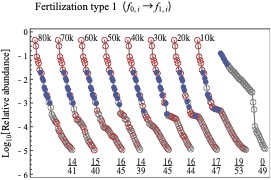
Over 40 years ago, Kempton (Biometrics, 35, 1979, 307) reported significant modification to plant community structure following a long-term fertilization experiment. Many researchers have investigated this phenomenon in the years since. Collectively, these studies have shown consistent shifts in rank abundance relationships among species in communities following fertilization. The previous studies indicated that fertilization affects community structure through several critical processes, including trait-based functional response, reordering of species in rank abundance diagram (RAD), and niche dimensionality, although some questions have remained. How does the species reordering driven by the plant responses cause characteristic trends in temporal changes of RAD? Why are those trends ubiquitous in various systems? To answer those questions, we theoretically investigated the effects of fertilization on community structure based on a colonization model (or Levins model) with competition–fecundity trade-offs, which can result in the coexistence of multiple species under competition. The model represents characteristic RAD, which can be an adequate tool to study community composition. Our theoretical model comprehensively represents observed trends in rank abundance relationships following long-term
fertilization and suggests that competitive interactions among species are a critical factor in structuring species diversity in plant communities.
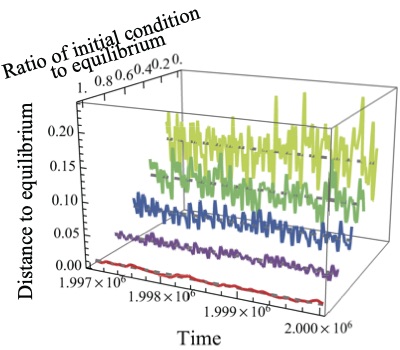
The colonization model formulates competition among propagules for habitable sites to colonize, which serves as a mechanism enabling coexistence of multiple species. This model traditionally assumes that encounters between propagules and sites occur as mass action events, under which species distribution can eventually reach an equilibrium state with multiple species in a constant environment. To investigate the effects of encounter mode on species diversity, we analyzed community dynamics in the colonization model by varying encounter processes. The analysis indicated that equilibrium is approximately neutrally-stable under perfect ratio-dependent encounter, resulting in temporally continuous variation of species’ frequencies with irregular trajectories even under a constant environment. Although the trajectories significantly depend on initial conditions, they are considered to be "strange nonchaotic attractors" (SNAs) rather than chaos from the asymptotic growth rates of displacement. In addition, trajectories with different initial conditions remain different through time, indicating that the system involves an infinite number of SNAs. This analysis presents a novel mechanism for transient dynamics under competition.
2. Studies of inter-specific interactions
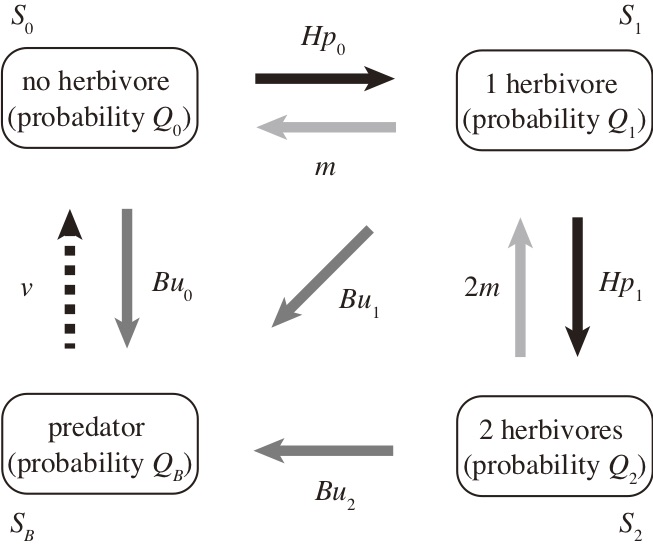
For a communication system to be stable, senders should convey honest information. Providing dishonest information, however, can be advantageous to senders, which poses a constraint on the evolution of communication systems. Beyond single populations and bitrophic systems, one may ask whether stable communication systems can evolve in multitrophic systems. Consider cross-species signalling where herbivory-induced plant volatiles (HIPVs) attract predators to reduce the damage from arthropod herbivores. Such plant signals may be honest and help predators to identify profitable prey/plant types via HIPV composition and to assess prey density via the amount of HIPVs. There could be selection for dishonest signals that attract predators for protection from possible future herbivory. Recently, we described a case in which plants release a fixed, high amount of HIPVs independent of herbivore load, adopting what we labeled a ‘cry-wolf’ strategy. To understand when such signals evolve, we model co-evolutionary interactions between plants, herbivores and predators and show that both ‘honest’ and ‘cry-wolf’ types can emerge, depending on the assumed plant-herbivore encounter rates and herbivore population density. It is suggested that the ‘cry-wolf’ strategy may have evolved to reduce the risk of heavy damage in the future. Our model suggests that eco-evolutionary feedback loops involving a third species may have important consequences for the stability of this outcome.
Two herbivorous species that share a single plant can interact indirectly with one another, even without direct interaction. One type of indirect interaction is exploitative resource competition, which results from a reduction in plant biomass; another type is that caused by changes in plant traits. These are referred to as indirect effects, mediated, respectively, by biomass and plant traits. The two indirect effect types often occur simultaneously, and they are difficult to partition. To investigate the roles of the two indirect effects on both herbivores, a dynamic one-plant, two-herbivore system model was analyzed assuming the spatiotemporal co-occurrence of the herbivores and the plants’ non-specific induced defenses. Our analysis revealed that the densities of coexisting competitively superior and subordinate herbivores were regulated by negative indirect effects mediated by plant biomass and defense, respectively. This indicates that indirect effects mediated by plant biomass and plant traits can be important regulators of herbivore population size in equilibrium with herbivore coexistence. Our results could be generally applicable to plant–herbivore interactions with non-specific plant defense that is induced through both intra- and transgenerational responses.
3. Evolution of cooperation

In kin selection theory in the evolution of social behaviours, the relatedness between interacting individuals is influenced by the spatial structure of the population. It is generally considered that in the 'viscous' population competition among individuals tends to suppress the evolution of altruism. We consider that more complex interactions produce specific spatial patterns in the presence of competitive interaction, which could alter the process of kin selection in a given space. Here, we theoretically studied the joint evolution of altruism and resource exploitation in a spatially structured population. The simulations indicated that joint evolution can result in self-organisation of regularly arranged cluster structures, which creates a new 'level of selection', and significantly promotes the evolution of altruism through a promotion of kin selection. The analysis also suggested synergetic effects of the joint evolution of two traits, including an evolutionary suicide of the population.
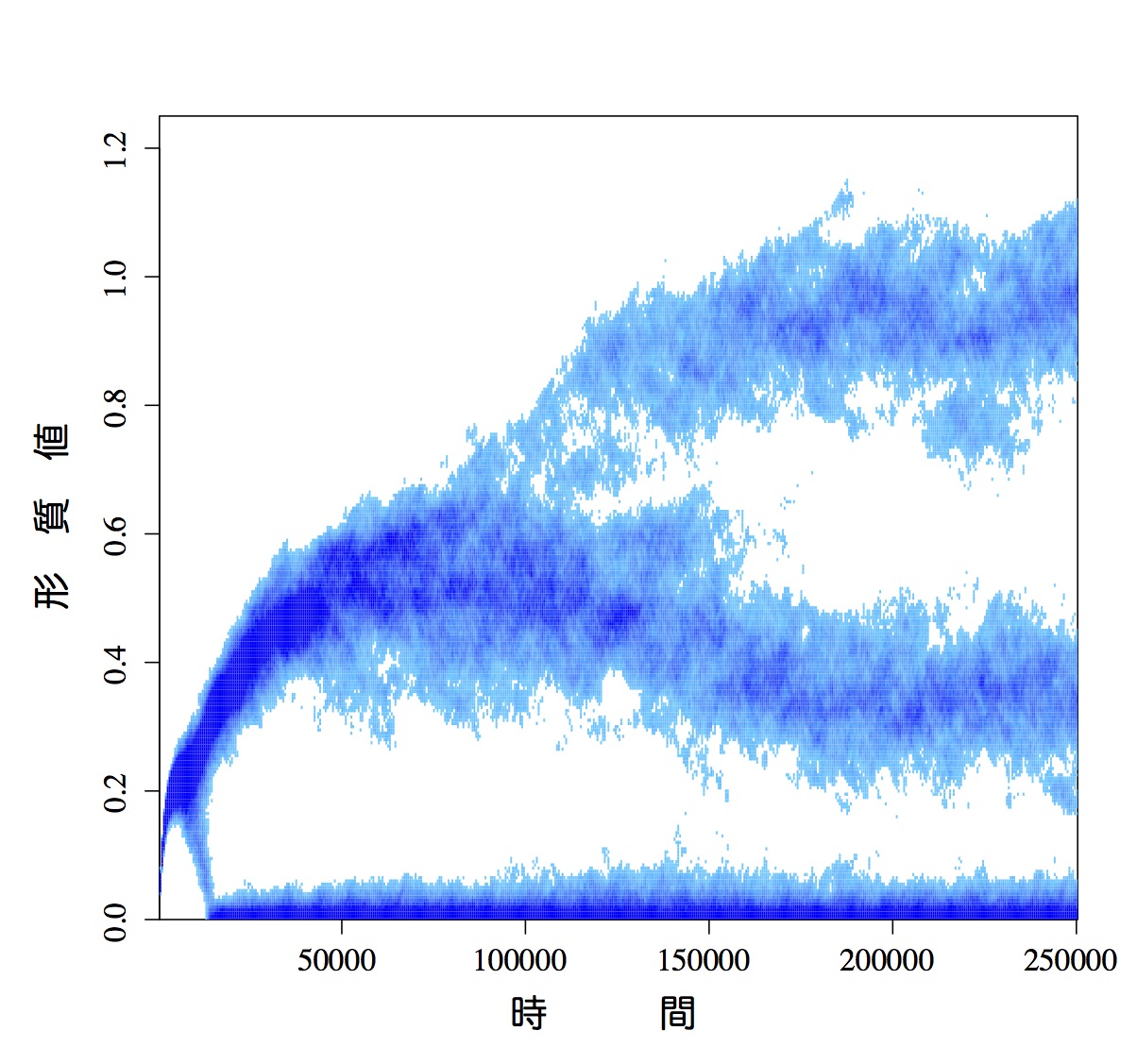
The existence of intra-population variations in cooperation level has often been reported by some empirical studies. Evolutionary conditions of polymorphism in cooperation have been investigated by using a framework of the continuous snowdrift game. However, our insights from this framework have been limited because of an assumption that the cooperative reward is a function of total amount of investments within an interacting group. In many cases, payoffs may actually depend on the interactions between the effects of such investments, such as members share the sum of beneficial effects that are individually produced from their own investments. Alternatively, payoffs may depend multiplicatively on investment, such as when investments are complementary. In the present paper, we investigated the influence of such difference on the evolution of cooperation with respect to three aspects of the aggregating process of individuals’ contributions for reward, i.e. (i) additive or multiplicative, (ii) aggregation of either investments or effects, and (iii) promotion of advantage or suppression of disadvantage. We analytically show that the possibilities of the emergence of polymorphism are different depending on the type of aggregation process classified from these three aspects. Polymorphism of cooperation level never emerges unless the aggregation process is the aggregation of investment or the multiplicative aggregation of effect with suppression of disadvantage. Our results show the necessary condition for the emergence of polymorphic cooperation levels that are observed in various taxonomic groups.
4. Evolution of endosymbiont
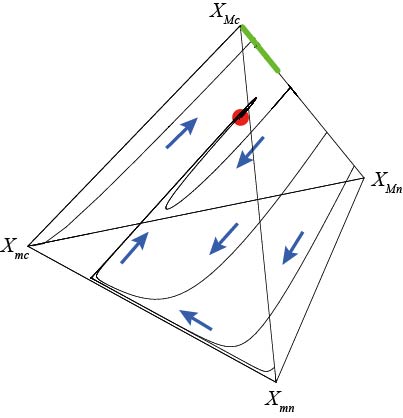
Gynodioecy is a sexual polymorphism in angiosperms, where hermaphroditic and female individuals coexist. This is often caused by a cytoplasmic genetic element (CGE) that destroys male functions, which is called cytoplasmic male-sterility (CMS). On the other hand, nuclear genes tend to evolve the ability to restore male function. The coevolutionary process of CMS and the restoration has been studied theoretically. Recently, a theoretical study suggested that these coevolutionary dynamics could be influenced by the rate of selfing within populations, although it assumed that the selfing rate of a population was a fixed parameter. Accordingly, we theoretically study the coevolution of three traits in this paper: CMS, nuclear restorer and selfing rate, in which we hypothesize that selfing evolution can suppress CMS evolution under some conditions. The analysis indicates three significant properties of the system; (1) CMS-restorer evolution can result in bistability under a given selfing rate, (2) the coevolution of three traits can realize intermediate levels of selfing, and (3) the evolution of high levels of selfing is conditionally associated with no CMS and/or no restoration, which may support our hypothesis.

